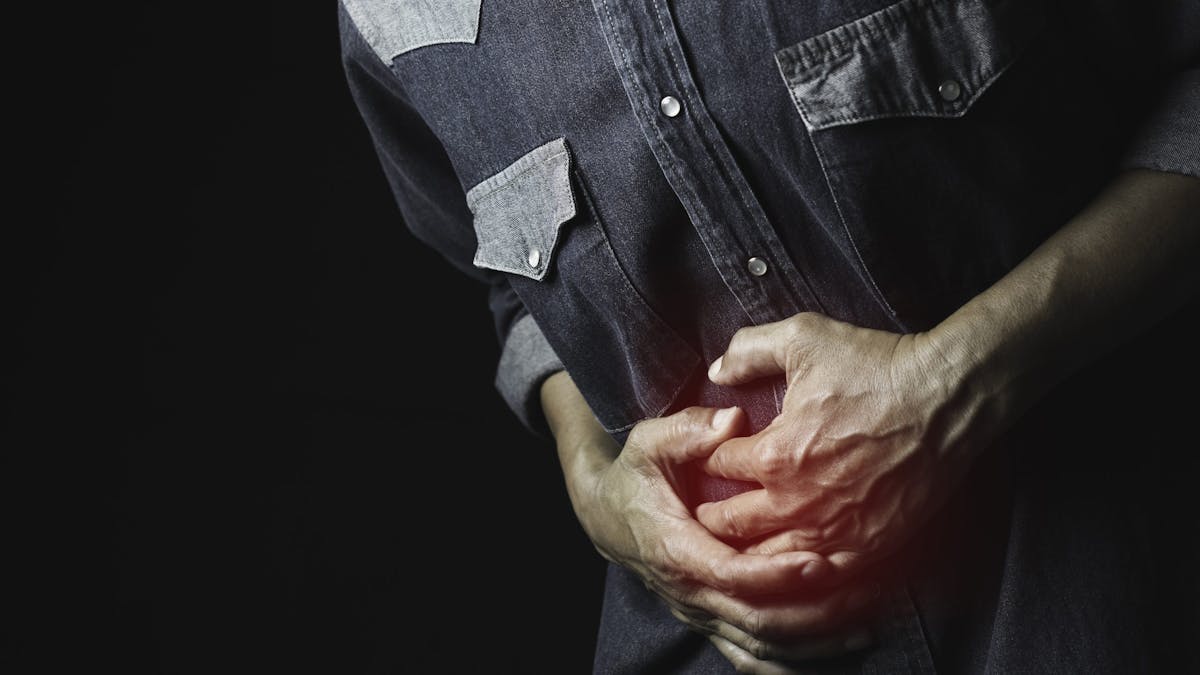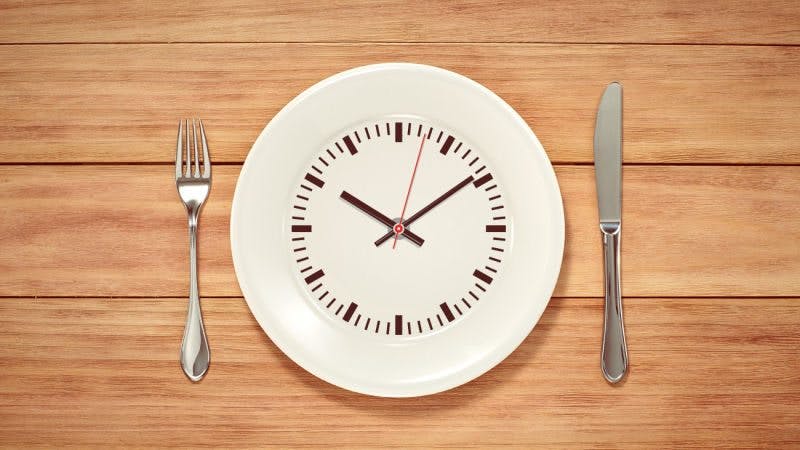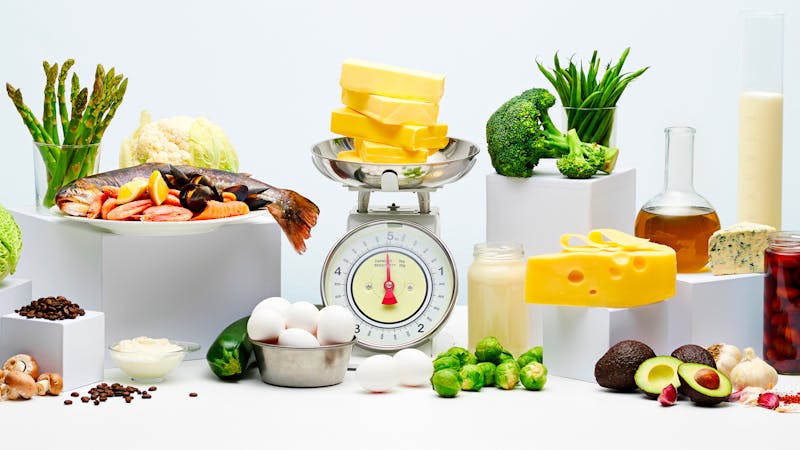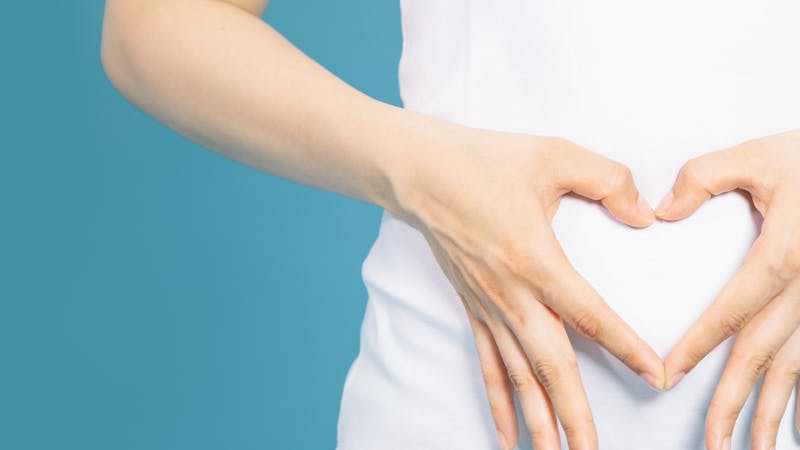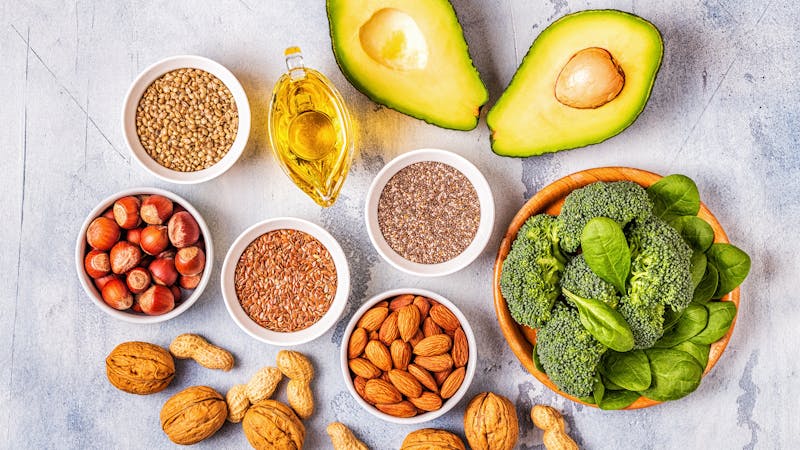Diverticulitis and the low carb diet
If you’ve ever had an attack of diverticulitis, which is due to inflammation or infection of a small pouch in the wall of the lower intestine, you’ll likely never forget it.1
Intense, sharp pain, usually on the lower left side of your abdomen, likely had you doubled-over in agony. The pain may have also radiated across your lower abdomen, to your belly button, or possibly into your back or side.2
If your attack was severe, possibly due to a perforation (hole) in your intestinal lining, you may have been hospitalized for treatment or required emergency surgery.
Clearly, you’ll want to do whatever you can to avoid another attack.

Questions about low carb
If you’ve had diverticular disease and you’re considering the low carb or keto diet for weight loss, diabetes reversal, or other health reasons, you may have questions:
- Can you safely do a low carb or keto diet with a history of diverticulitis?
- Could a low carb or keto diet potentially put you at a higher risk of another diverticulitis attack?
- Or, could a low carb or keto diet possibly help prevent a future attack?
This evidence-based guide will help answer these questions. It will explain what is known and not known about diverticulitis and highlight risk factors that can spur the condition.
The guide will also discuss the current research on which foods to eat or to avoid to prevent a recurrence of diverticulitis and during an acute diverticulitis attack.
What we know, and what we don’t
Let’s be upfront about one key point: in regards to the low carb or keto diet, no high-quality studies have examined diverticulitis and this way of eating. Well-designed randomized controlled studies are sorely needed.
However, to help bridge the current knowledge gap, the creation of this guide included consulting Diet Doctor’s international panel of medical experts and the international gastroenterologists listed on our Find a Doctor map of low carb physicians.
These low carb medical experts’ consensus is that a person with a history of diverticular disease can safely eat a low carb or keto diet without increasing their risk of a recurrence of this serious, painful condition.3
In fact, in their clinical experience, by helping reduce obesity, metabolic syndrome, and chronic inflammation and removing refined carbohydrates and sugar from the diet, the low carb, keto diet likely helps patients reduce their risk factors for an initial attack or recurrence.4
As a U.S. gastroenterologist and the author of this guide, I agree with this clinical opinion. I routinely recommend the low carb diet to virtually all my patients with gastrointestinal issues. In my clinical practice and through my research, I have no hesitation in recommending the low carb or keto diet for anyone with diverticular disease.
However, in the absence of definitive high-quality research evidence, you must be comfortable making a decision that is right for you. Read on for a more in-depth discussion of these complex issues around a common health condition.
What is diverticulitis?
Diverticulitis occurs when small pockets or pouches in the lining of the intestine become inflamed or infected. They can even perforate or rupture with subsequent leakage of intestinal contents into surrounding tissue in more complicated cases.

Why do diverticula occur in the first place? That’s not clear. It’s thought to be a mixture of aging and heredity, combined with other triggers, such as smoking, diet, or inflammation.
Takeaway
Diverticula are pockets or pouches found in the lining of the large intestine.
With diverticulosis, these pockets usually cause no problems or symptoms, but, in a small percentage of people, the pockets may become inflamed or infected, called diverticulitis. In complicated cases of diverticulitis, the pockets may even perforate, leading to serious complications.
How common is it?
Diverticular disease is common in Westernized countries. In fact, for the last century, it has been deemed a disease of Western civilization.
Rates of diverticular disease increase as individuals migrate to developed nations or whole countries adopt a more western lifestyle. The incidence of diverticular disease is now increasing in other parts of the world, like Africa and Asia, where it used to be very rare.8








Recent studies have found that only about 4% of those with diverticulosis will develop diverticulitis.10
Nevertheless, because diverticulosis is so common, millions of people in western countries experience a debilitating attack of diverticulitis each year. In the US alone, diverticulitis is the reason for more than 2.7 million outpatient visits and 200,000 hospitalizations annually.11
Another concerning trend is that the incidence of diverticulitis is increasing, especially among those under the age of 50, in whom it used to be very rare.12 This increase at younger ages is worrisome. That’s because the younger you are when diverticulosis is diagnosed, the higher your risk of eventually developing an attack of diverticulitis and then having recurring attacks.13
Takeaway
Diverticular disease is common in all westernized countries, especially with advancing age. However, fewer than 5% of people with diverticula will go on to have attacks of diverticulitis. In recent years the incidence of diverticulitis has been increasing, especially in people under age 50.
Risk factors for diverticular disease








Here is the research evidence to date:
- Genetics: If a family member had diverticulitis, you are at a higher risk of having it yourself. Recent research is showing genetic factors may be responsible for up to 50% of the risk of developing diverticular disease.14
- Smoking: Individuals who smoke are at higher risk of developing diverticula and have higher rates of complications if they develop diverticulitis. Women who smoke may be at a higher risk than men who smoke. 15
- Obesity: Obesity and excessive weight gain in adulthood increase the risk of diverticulosis, as well as the progression to diverticulitis. Those who are obese have more severe complications if diverticulitis arises.16
It is theorized, although not proven, that the risk may be more due to changes in the microbiome of the intestine, likely from eating highly processed sugar and starches.17
- Physical inactivity: A sedentary lifestyle is also associated with forming diverticula and having it progress to diverticulitis. Obese men who are inactive are at especially high risk. Observational studies suggest that vigorous exercise, such as running, even in overweight or obese individuals, may reduce the risk.18
- Diabetes: For those patients who have diverticula, having a corresponding diagnosis of diabetes increases the risk of developing diverticulitis, being hospitalized, and having more severe complications.19
- Medications: Several types of medications, including steroids, narcotics, and non-steroidal anti-inflammatory drugs (NSAIDs — common pain relievers like ibuprofen, naproxen) increase the risk for diverticulitis and for having more serious complications.20
- Inflammation: Chronic, low-grade inflammation, with or without obesity, is emerging as a key risk factor for diverticulitis. Low-grade inflammation is now seen as playing one of the most important roles in the potential creation of diverticula. As we stated before, dietary choices can play a significant role in triggering inflammation.21
- Vitamin D: Low levels of vitamin D have emerged as a possible risk factor for diverticulitis attacks. Seasonal and geographic variations in diverticulitis rates correspond to exposure to sunlight and presumed vitamin D status. Research studies found that low vitamin D levels are significantly associated with higher rates of diverticulitis and more severe complications. This does not mean that vitamin D supplements prevent diverticulitis. More research is needed to identify whether it’s the vitamin D or other confounding factors that impact diverticulitis.22
- Diet: For decades, a person’s diet has been assumed to be one of the dominant risk factors, especially a low fiber diet. But recent research results have been inconsistent and conflicting, calling dietary factors into question.23 What is currently known about the role of various foods to eat or not to eat is detailed in the next section.
Takeaway
Several risk factors are associated with higher rates of diverticular disease, including advancing age, genetics, smoking, obesity, inactivity, diabetes, inflammation, altered microbiome, and perhaps a vitamin D deficiency. Dietary factors are assumed to be a risk, but results are inconsistent.


Foods to eat or avoid
What food should you eat to prevent diverticular disease? What foods should you avoid?
The role of specific food groups as factors in both causing and preventing diverticular disease has been a focus of study for decades. However, the research is still highly controversial and full of conflicting results.
Here is what current research says about specific foods:
Fiber
For decades it was thought that not eating enough fiber in the diet, and the resulting constipation, caused diverticulosis and increased the risk of diverticulitis.24 However, as one prominent researcher has recently noted, the fiber deficiency hypothesis “existed for four decades without any proof.”25
Over the last decade, some studies have found that eating more fiber does not prevent diverticula from forming.26
Likewise, a few recent studies have also shown that, counter to the medical dogma for 50 years, constipation seems to have little or no relation to diverticular disease.27
In fact, some studies are now suggesting that higher fiber diets, and more frequent bowel movements, may be more likely to be associated with the creation of diverticula.28
However, here’s where it gets more complicated. While high fiber diets may not prevent diverticula from forming, observational data suggest that a high fiber diet may reduce the risk of an acute attack of diverticulitis and may prevent more serious complications.29
Whether an increase in fiber increases the risk of developing diverticulosis but reduces the likelihood of developing diverticulitis will require further study. The conflicting results may also be related to the type of fiber that is consumed, such as whether a fiber is soluble or insoluble, or from fruit and vegetables rather than cereal grains or bran.
However, eating a high fiber diet seems to be good for general health, independent of diverticular disease.30 For a greater understanding about various types of fiber and how to get more low carb fiber in your diet, please see Diet Doctor’s evidence-based guide: 15 high fiber foods that are low in carbs.
Nuts, seeds, and popcorn








It was thought these hard, undigested bits of food were more likely to get caught in the diverticular pouches or scratch or irritate them, leading to inflammation and infection.
However, the advice to avoid foods like popcorn, raspberries, strawberries, blackberries, and nuts was based on a logical assumption and lacked scientific evidence. In 2008, a large prospective study, which followed more than 47,000 men over 18 years, found no relationship between eating nuts, seeds, and popcorn and the incidence of diverticulitis. In fact, men who ate the most nuts and popcorn had less diverticulitis than men who ate the least.31
Meat
Observational data show that eating large amounts of unprocessed red meat is associated with an increased incidence of diverticulitis in men.32
However, like many studies about meat consumption in recent years, in this study, men with the highest consumption of red meat also tended to smoke more, used NSAIDs more, and were less likely to exercise than the men with the lowest meat consumption. This is called the healthy user bias.
As well, the study suffers from the many other methodological flaws of observational nutrition studies, including that the relative risk difference between the highest level of meat-eaters and the lowest was very small.33
The Diet Doctor evidence-based guide on red meat goes into more detail about the poor quality, observational evidence that makes it very difficult to make any strong conclusions about the impact of red meat consumption on various health conditions.
“Healthy” or “prudent” diet — or no special diet at all?
Some researchers advise that to reduce your risk of diverticulitis, eat a “healthy,” non-Western or “prudent” diet. What does that mean? The researchers describe the “Western” dietary pattern as one with a high intake of red and processed meats, refined grains, sweets, French fries, and high fat dairy products. A “prudent diet” was described as high in fruits, vegetables, whole grains, legumes, poultry, and fish.34
What part of the prudent diet actually decreases the risk? Could it be that eliminating refined grains and sweets is the essential part of decreasing the risks of diverticulitis? This research question has not been explored.
One small but influential study found that during an attack of uncomplicated (or less severe) diverticulitis, it didn’t really matter what people ate, that an unrestricted or liberal diet had the same outcomes as those who restricted certain foods.35 This finding, along with the other conflicting dietary studies, has led many doctors and dietitians to no longer recommend specific diets.
Nevertheless, many people with recurrent diverticulitis find that some specific foods tend to precede their attacks and learn to recognize and avoid their personal triggers. Paying attention to your possible dietary triggers may help you manage your diverticular disease.
Takeaway
The role of a high fiber diet in diverticulosis and diverticulitis is now questioned and complicated by weak associational data.
Nuts, seeds, and popcorn do not seem to be associated with attacks.
The general advice is to eat a “healthy” or “prudent diet” but specific restricted diets may not be necessary and individuals should find the diet that is right for them.
Low carb, ketogenic diet




As noted in the opening of this guide, currently no high-quality trial has been conducted comparing a low carb or ketogenic diet to other dietary patterns among those who have diverticular disease.
Diet Doctor’s expert panel and gastroenterologists who recommend low carb diets on our Find a Doctor page were consulted. The consensus is that in their clinical experience the diet is safe for those with diverticular disease.36
They make the following observations as to why they recommend low carb to patients with diverticular disease:
- The unexplored role of sugar and refined carbohydrates in diverticular disease: As a disease of Western civilization, diverticulitis has increased in parallel with the consumption of sugar and refined carbohydrates since the 1860s. In fact, a highly influential research paper in 1971 hypothesized that diets high in sugar and refined carbohydrates could be the key underlying risk factors for the development of diverticular disease.37 However, this observation about the role of sugar and refined carbohydrates was ignored in favor of holding low fiber diets responsible for diverticular disease for the next 50 years.
To date, no research has been carried out on any possible links between high consumption of sugar, refined carbohydrates and processed food. We believe these food groups should be studied, given the risk factors of obesity, diabetes, and chronic inflammation underlying diverticular disease.
- Obesity: A low carb or ketogenic diet is effective for weight loss and weight maintenance.38
- Diabetes: A low carb or ketogenic diet is an effective method to reduce blood sugar and may reverse diabetes.39
Anecdotally, many people eating a low carb or ketogenic diet report an improvement in other inflammation and gastrointestinal symptoms, including a reduction in irritable bowel syndrome (IBS), heartburn (gastric reflux), and inflammatory bowel disease.40
Our guide IBS and the keto diet provides more in-depth discussion around the research and clinical experience for this other common intestinal condition.
Diet Doctor has success stories from Ruth and Jennifer about how they feel they greatly improved their symptoms of diverticular disease by eating a ketogenic diet.
Takeaway
Studies show that obesity, diabetes, metabolic syndrome, and markers of chronic inflammation respond well to a low carb, ketogenic diet. Since these are risk factors for diverticular disease, reducing them may help decrease the risk of diverticulitis. Plus, anecdotal evidence is increasing that symptoms and flares of diverticular disease may be reduced by low carb eating. But scientific studies showing this are lacking.
Intermittent fasting
During an attack of diverticulitis, the medical recommendation is that patients should only consume clear fluids for two or three days or until their symptoms improve. If the attack is more severe (called complicated diverticulitis), the recommendation is to take nothing by mouth until the diverticulitis heals.41 This is a therapeutic form of intermittent fasting to heal the gut.
A clear fluids diet means consuming water, sparkling water, mineral water, unsweetened tea, black coffee, consommé, and bone broth. Some doctors allow sweetened clear juice, jello, sugary drinks, or diet drinks with artificial sweeteners, but low carb doctors, like myself and others on the Diet Doctor expert panel, recommend avoiding all fluids with sugar and artificial sweeteners.42
My clinical advice is that if you are doing the low carb diet and happen to have a flare of diverticulitis, you may want to fast for a few days, drinking only clear beverages. But when you feel better, you can go right back to the low carb diet.
Could adopting intermittent fasting in times other than acute attacks help prevent or reduce flares of diverticular disease?
Unfortunately, no research studies have been conducted on the possible role of regular episodes of intermittent fasting on diverticular disease. Good studies are needed. However, a logical argument can be made that periods of fasting could be beneficial to the underlying intestinal pathology of diverticular disease.43
A short pattern of intermittent fasting, such as skipping breakfast or eating one meal a day (OMAD) is unlikely to be harmful for someone with diverticular disease and can help with weight loss, diabetes, and blood sugar management.
For more information about intermittent fasting, see Diet Doctor’s guides and videos.
Takeaway
A clear liquid fast for two or three days is recommended for treating acute diverticulitis.
Research is lacking for the regular use of intermittent fasting to prevent flares of diverticular disease, but intermittent fasting is effective for underlying risk factors such as obesity and diabetes.
The clinical opinion of low carb experts is that fasting is safe and may even be beneficial for diverticular disease.
Summary
Diverticular disease is common among the populations of all Westernized countries, particularly as people age. Obesity, diabetes, smoking, inactivity, and chronic inflammation are all risk factors.
A high fiber diet likely does not prevent the development of diverticular disease, but it may reduce complications and hospitalizations from acute attacks.
Doctors and dietitians no longer recommend specific restricted diets for diverticular disease, and so you are encouraged to find a diet that works best for you and makes you feel your healthiest. For many people, this may be a low carb or ketogenic diet.
No research evidence is not yet available to make conclusions about a low carb diet, keto diet, or intermittent fasting, in relation to diverticular disease. However, clinical experience, and some patient testimonies suggest that both the diet and periodic fasting is not only safe but could be beneficial for the health of the entire digestive tract.
Start your FREE 30-day trial!
Get instant access to healthy low carb and keto meal plans, fast and easy recipes, weight loss advice from medical experts, and so much more. A healthier life starts now with your free trial!
Start FREE trial!
Learn how to do a keto diet
One point we will make a few times in this guide is the difference between diverticulosis and diverticulitis. It can be confusing, even for some medical folks! Diverticulosis is simply the presence of diverticula or outpouchings in the wall of the intestine. Diverticulitis is the complication that occurs when these diverticula become inflamed, infected, or even rupture. ↩
Fever, chills, gas, bloating, diarrhea, constipation, nausea, or vomiting may also have been some of the unpleasant symptoms.
Annals of Internal Medicine 2019. In the clinic: acute colonic diverticulitis [expert review, ungraded] ↩
This is based on consistent clinical experience of practitioners who use low carb diets. [weak evidence] ↩
This is based on consistent clinical experience of practitioners who use low carb diets. [weak evidence] ↩
A way to remember these confusing, related medical terms is that “osis” always means a state or condition, and “itis” means an infection or inflammation. So, diverticulitis literally means infection of the diverticula. Diverticular disease is the umbrella name given for all these related conditions. ↩
In Europe and North America, the diverticula most often arise in the lower left colon, called the sigmoid or descending colon. In Asia, the pouches most often occur on the right side, in the ascending colon. The reason for the regional and ethnic differences in diverticula location is unknown, but it’s thought to be related to a combination of genetics and the environment.
Nature Reviews Disease Primers 2020. Colonic diverticular disease [expert review, ungraded] ↩
Clinical Gastroenterology and Hepatology 2013: Long-term risk of acute diverticulitis among patients with incidental diverticulosis found during colonoscopy [longitudinal case series study, weak evidence] ↩
Colorectal Diseases 2011: The changing trend of diverticular disease in a developing nation [retrospective cohort study, weak evidence]
Alimentary Pharmacology and Therapeutics 2006. Diverticular disease and migration — the influence of acculturation to a western lifestyle on diverticular disease [prospective cohort study, weak evidence] ↩
More than 50% of Americans over the age of 60 will have one or more diverticula. By age 80, more than 70% of Americans have findings of diverticulosis — most of them with no evidence of inflammation or symptoms.
Gastroenterology 2019: Epidemiology, pathophysiology, and treatment of diverticulitis [expert review, ungraded]
Remember what we previously mentioned– A way to remember these confusing, related medical terms is that “osis” always means a state or condition, and “itis” means an infection or inflammation. So, diverticulitis literally means infection of the diverticula. Diverticular disease is the umbrella name given for all these related conditions.
↩It used to be thought that 20 to 25% of people with diverticulosis would eventually develop diverticulitis. Now we know that the chance of developing diverticulitis is much less common.
Clinical Gastroenterology and Hepatology 2013: Long-term risk of acute diverticulitis among patients with incidental diverticulosis found during colonoscopy [longitudinal case series study, weak evidence] ↩
Gastroenterology 2015: Burden of gastrointestinal, liver and pancreatic diseases in the United States [statistical analysis; ungraded] ↩
Rates have increased by 132% in the 40 to 49 age group since the 1980s. One factor that may be behind this increase in younger ages may be increasing rates of obesity.
Gastroenterology 2019: Epidemiology, pathophysiology, and treatment of diverticulitis [expert review, ungraded]
American Journal of Gastroenterology 2015. Temporal trends in the incidence and natural history of diverticulitis: a population-based study [retrospective cohort study, weak evidence] ↩
Clinical Gastroenterology and Hepatology 2013: Long-term risk of acute diverticulitis among patients with incidental diverticulosis found during colonoscopy [longitudinal case series study, weak evidence] ↩
Aliment Pharmacology and Therapy 2012. The genetic influence on diverticular disease – a twin study [retrospective cohort study; weak evidence]
Gastroenterology 2013. Heritability and familial aggregation of diverticular disease: a population-based study of twins and siblings [retrospective cohort study, weak evidence]
Genome studies have identified a number of possible genes, including genes related to connective tissue structure, immune function, inflammation, and intestinal motility.
Nature Genetics 2018. Genome-wide association analyses identify 39 new susceptibility loci for diverticular disease [genetic data analysis, ungraded] ↩
Smoking impairs blood flow, and a lack of blood flow to the colon wall may explain this.
Journal of Postgraduate Medicine 2018. Smoking and risk of colonic diverticulosis: A meta-analysis [meta-analysis of observational studies, weak evidence] ↩
Gastroenterology 2009. Obesity increases the risks of diverticulitis and diverticular bleeding [cohort studies, weak evidence]
Gastroenterology 2018: Association between obesity and weight change and risk of diverticulitis in women [prospective cohort study, weak evidence] ↩
Sugars and refined carbohydrates can predispose to bacterial overgrowth and inflammation, which may eventually weaken the colon wall.
Gut 2017. Gut microbiota, metabolome and immune signatures in patients with uncomplicated diverticular disease [observational study; weak evidence] ↩
American Journal of Gastroenterology 2009. Physical activity decreases diverticular complications [prospective cohort study, weak evidence] ↩
American Journal of Therapeutics 2017: Diabetes increases morbidities of colonic diverticular disease and colonic diverticular hemorrhage: a systematic review and meta-analysis [systematic review of observational studies; weak evidence] ↩
Many patients with diverticulosis take NSAIDs for joint pain or headaches, which increases the risk for diverticulitis 1.8 times. Patients on steroids and narcotics are at greater risk of having a free perforation into the abdominal cavity, the most serious and life-threatening complication of diverticulosis.
Gut 2011: Concurrent drug use and the risk of perforated colonic diverticular disease: a population-based case-control study [retrospective cohort study, weak evidence] ↩
Inflammatory Intestinal Diseases 2018: The pathophysiology of colonic diverticulosis: inflammation versus constipation? [expert review, ungraded]
Mediators of Inflammation 2019: Role of Inflammation in the Pathogenesis of Diverticular Disease [expert review, ungraded] ↩
Clinical Gastroenterology and Hepatology 2014. Higher serum levels of vitamin D are associated with a reduced risk of diverticulitis [retrospective cohort study, weak evidence]
Journal of Clinical Gastroenterology and Liver Disease 2016. Serum levels of vitamin D are associated with the severity of the endoscopic appearance of diverticular disease of the colon according to DICA classification [retrospective cohort study, weak evidence] ↩
Annals of Gastroenterology 2019. Paradigm shift: the Copernican revolution in diverticular disease [expert review, ungraded] ↩
British Medical Journal 1971: Diverticular disease of the colon: A deficiency disease of western civilization [expert review, ungraded] ↩
Clinical Gastroenterology and Hepatology 2013. Diverticular disease: Reconsidering conventional wisdom [expert review, ungraded] ↩
Gastroenterology 2012: A high fiber diet does not protect against diverticulosis [prospective cohort study, weak evidence] ↩
International Journal of Surgery 2015. Constipation is not associated with diverticular disease – Analysis of 976 patients [prospective cohort study, weak evidence]
Inflammatory Intestinal Diseases 2018: The Pathophysiology of Colonic Diverticulosis: Inflammation versus Constipation? [expert review, ungraded] ↩
Gastroenterology 2012: A high fiber diet does not protect against diverticulosis [prospective cohort study, weak evidence] ↩
European Journal of Nutrition 2019: High intake of dietary fibre from fruit and vegetables reduces the risk of hospitalisation for diverticular disease [prospective cohort study, weak evidence]
European Journal of Nutrition 2020: Dietary fibre intake and the risk of diverticular disease: a systematic review and meta-analysis of prospective studies [systematic review of observational studies; weak evidence]
However, as with many observational nutrition studies, these reports suffer from “healthy user bias” as well as other methodological weaknesses. ↩
This has mostly been shown for high carb diets, so it is unclear if the same beneficial effects of fiber relate to low carb diets as well ↩
Journal of the American Medical Association 2008. Nut, corn, and popcorn consumption and the incidence of diverticular disease [prospective cohort study, weak evidence] ↩
Gut 2018. Meat intake and risk of diverticulitis among men [prospective cohort study, weak evidence] ↩
Out of the population of 46,461 men followed, only 764 cases of diverticulitis occurred over 18 years, meaning only 1.6% of the population developed the condition over this long time span. Among the men who ate the most meat, their relative risk was increased only 1.5 times, giving them a total overall risk of about 2.4% of developing diverticulitis, an increase of only 0.8%. ↩
Gastroenterology 2017: Western dietary pattern increases, and prudent dietary pattern decreases, risk of incident diverticulitis in a prospective cohort study [prospective cohort study, weak evidence]
American Journal of Gastroenterology 2017: Adherence to a Healthy Lifestyle is Associated With a Lower Risk of Diverticulitis among Men [observational study, weak evidence] ↩
Colorectal Disease 2017: An unrestricted diet for uncomplicated diverticulitis is safe: results of a prospective diverticulitis diet study [prospective cohort study, weak evidence] ↩
This is based on consistent clinical experience of practitioners who use low carb diets. [weak evidence] ↩
Diverticular disease of the colon: a deficiency of Western civilization [expert review, ungraded] ↩
PLoS One 2015: Dietary intervention for overweight and obese adults: Comparison of low carbohydrate and low fat diets. A meta-analysis [strong evidence]
The British Journal of Nutrition 2016: Effects of low carbohydrate diets v. low fat diets on body weight and cardiovascular risk factors: a meta-analysis of randomised controlled trials [strong evidence] ↩
Diabetes Research and Clinical Practice 2018: Effect of dietary carbohydrate restriction on glycemic control in adults with diabetes: A systematic review and meta-analysis [strong evidence]
BMJ Open Diabetes Research and Care 2017: Systematic review and meta-analysis of dietary carbohydrate restriction in patients with type 2 diabetes [strong evidence] ↩
Annals of Internal Medicine 2019. In the clinic: acute colonic diverticulitis [expert review, ungraded] ↩
This is based on consistent clinical experience of low carb practitioners. [weak evidence] ↩
This is an unstudied hypothesis and is not based on scientific research ↩
